Gene Variation: Molecular Genetics, Evolution, and Adaptation
VerifiedAdded on 2019/10/01
|13
|2481
|389
Essay
AI Summary
This essay provides a comprehensive overview of gene variation, exploring its significance in molecular genetics, evolution, and adaptation. It begins by discussing the historical advancements in molecular genetics, including the development of protein electrophoresis and DNA sequencing, and their impact on understanding genetic variation in natural populations. The essay then delves into the uses of genetic data in various fields, emphasizing the role of genetic variation in species adaptation, conservation, and the identification of distinct populations. It elaborates on the causes of genetic variation, including mutation, random mating, and recombination, and how these factors contribute to evolution. The essay also covers Mendel's Laws of Segregation and Independent Assortment, explaining how these principles govern the inheritance of alleles and the calculation of genotypic and phenotypic ratios. Furthermore, it highlights the application of the Punnett square and the forked-line method in analyzing genetic crosses. Overall, the essay underscores the importance of genetic variation in understanding biological processes and its implications for conservation and evolution.

Running head: GENE VARIATION
GENE VARIATION
Name of the Student
Name of the University
GENE VARIATION
Name of the Student
Name of the University
Paraphrase This Document
Need a fresh take? Get an instant paraphrase of this document with our AI Paraphraser
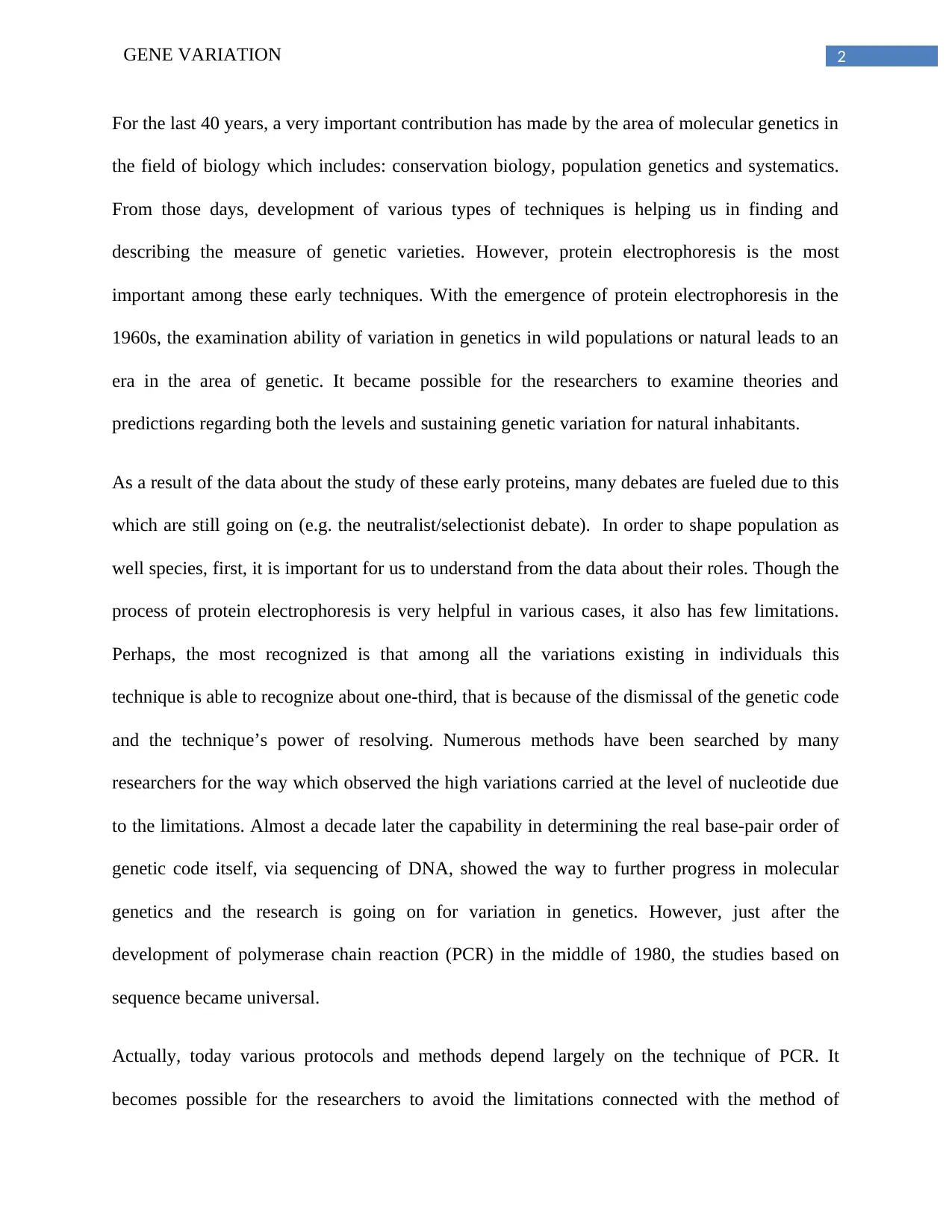
2GENE VARIATION
For the last 40 years, a very important contribution has made by the area of molecular genetics in
the field of biology which includes: conservation biology, population genetics and systematics.
From those days, development of various types of techniques is helping us in finding and
describing the measure of genetic varieties. However, protein electrophoresis is the most
important among these early techniques. With the emergence of protein electrophoresis in the
1960s, the examination ability of variation in genetics in wild populations or natural leads to an
era in the area of genetic. It became possible for the researchers to examine theories and
predictions regarding both the levels and sustaining genetic variation for natural inhabitants.
As a result of the data about the study of these early proteins, many debates are fueled due to this
which are still going on (e.g. the neutralist/selectionist debate). In order to shape population as
well species, first, it is important for us to understand from the data about their roles. Though the
process of protein electrophoresis is very helpful in various cases, it also has few limitations.
Perhaps, the most recognized is that among all the variations existing in individuals this
technique is able to recognize about one-third, that is because of the dismissal of the genetic code
and the technique’s power of resolving. Numerous methods have been searched by many
researchers for the way which observed the high variations carried at the level of nucleotide due
to the limitations. Almost a decade later the capability in determining the real base-pair order of
genetic code itself, via sequencing of DNA, showed the way to further progress in molecular
genetics and the research is going on for variation in genetics. However, just after the
development of polymerase chain reaction (PCR) in the middle of 1980, the studies based on
sequence became universal.
Actually, today various protocols and methods depend largely on the technique of PCR. It
becomes possible for the researchers to avoid the limitations connected with the method of
For the last 40 years, a very important contribution has made by the area of molecular genetics in
the field of biology which includes: conservation biology, population genetics and systematics.
From those days, development of various types of techniques is helping us in finding and
describing the measure of genetic varieties. However, protein electrophoresis is the most
important among these early techniques. With the emergence of protein electrophoresis in the
1960s, the examination ability of variation in genetics in wild populations or natural leads to an
era in the area of genetic. It became possible for the researchers to examine theories and
predictions regarding both the levels and sustaining genetic variation for natural inhabitants.
As a result of the data about the study of these early proteins, many debates are fueled due to this
which are still going on (e.g. the neutralist/selectionist debate). In order to shape population as
well species, first, it is important for us to understand from the data about their roles. Though the
process of protein electrophoresis is very helpful in various cases, it also has few limitations.
Perhaps, the most recognized is that among all the variations existing in individuals this
technique is able to recognize about one-third, that is because of the dismissal of the genetic code
and the technique’s power of resolving. Numerous methods have been searched by many
researchers for the way which observed the high variations carried at the level of nucleotide due
to the limitations. Almost a decade later the capability in determining the real base-pair order of
genetic code itself, via sequencing of DNA, showed the way to further progress in molecular
genetics and the research is going on for variation in genetics. However, just after the
development of polymerase chain reaction (PCR) in the middle of 1980, the studies based on
sequence became universal.
Actually, today various protocols and methods depend largely on the technique of PCR. It
becomes possible for the researchers to avoid the limitations connected with the method of
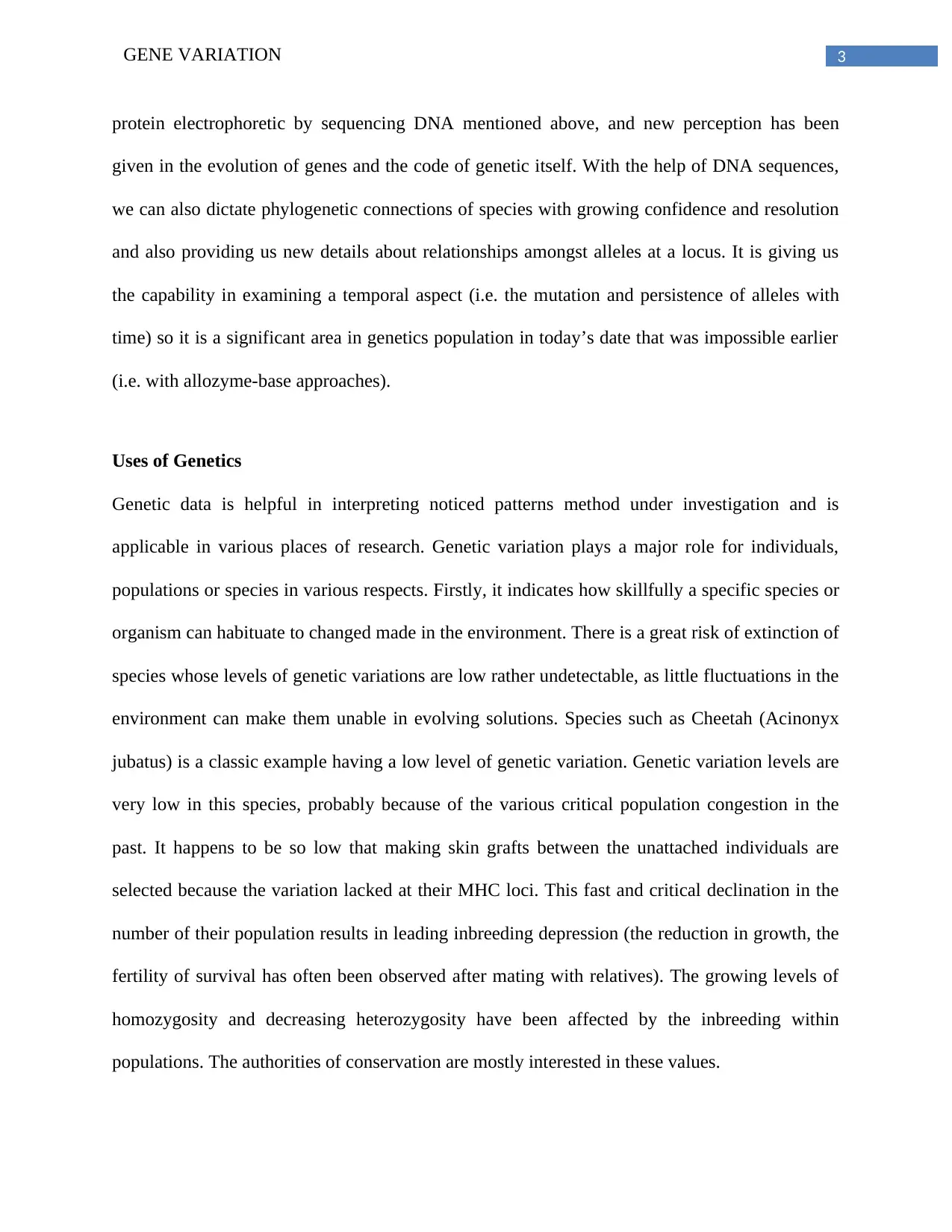
3GENE VARIATION
protein electrophoretic by sequencing DNA mentioned above, and new perception has been
given in the evolution of genes and the code of genetic itself. With the help of DNA sequences,
we can also dictate phylogenetic connections of species with growing confidence and resolution
and also providing us new details about relationships amongst alleles at a locus. It is giving us
the capability in examining a temporal aspect (i.e. the mutation and persistence of alleles with
time) so it is a significant area in genetics population in today’s date that was impossible earlier
(i.e. with allozyme-base approaches).
Uses of Genetics
Genetic data is helpful in interpreting noticed patterns method under investigation and is
applicable in various places of research. Genetic variation plays a major role for individuals,
populations or species in various respects. Firstly, it indicates how skillfully a specific species or
organism can habituate to changed made in the environment. There is a great risk of extinction of
species whose levels of genetic variations are low rather undetectable, as little fluctuations in the
environment can make them unable in evolving solutions. Species such as Cheetah (Acinonyx
jubatus) is a classic example having a low level of genetic variation. Genetic variation levels are
very low in this species, probably because of the various critical population congestion in the
past. It happens to be so low that making skin grafts between the unattached individuals are
selected because the variation lacked at their MHC loci. This fast and critical declination in the
number of their population results in leading inbreeding depression (the reduction in growth, the
fertility of survival has often been observed after mating with relatives). The growing levels of
homozygosity and decreasing heterozygosity have been affected by the inbreeding within
populations. The authorities of conservation are mostly interested in these values.
protein electrophoretic by sequencing DNA mentioned above, and new perception has been
given in the evolution of genes and the code of genetic itself. With the help of DNA sequences,
we can also dictate phylogenetic connections of species with growing confidence and resolution
and also providing us new details about relationships amongst alleles at a locus. It is giving us
the capability in examining a temporal aspect (i.e. the mutation and persistence of alleles with
time) so it is a significant area in genetics population in today’s date that was impossible earlier
(i.e. with allozyme-base approaches).
Uses of Genetics
Genetic data is helpful in interpreting noticed patterns method under investigation and is
applicable in various places of research. Genetic variation plays a major role for individuals,
populations or species in various respects. Firstly, it indicates how skillfully a specific species or
organism can habituate to changed made in the environment. There is a great risk of extinction of
species whose levels of genetic variations are low rather undetectable, as little fluctuations in the
environment can make them unable in evolving solutions. Species such as Cheetah (Acinonyx
jubatus) is a classic example having a low level of genetic variation. Genetic variation levels are
very low in this species, probably because of the various critical population congestion in the
past. It happens to be so low that making skin grafts between the unattached individuals are
selected because the variation lacked at their MHC loci. This fast and critical declination in the
number of their population results in leading inbreeding depression (the reduction in growth, the
fertility of survival has often been observed after mating with relatives). The growing levels of
homozygosity and decreasing heterozygosity have been affected by the inbreeding within
populations. The authorities of conservation are mostly interested in these values.
⊘ This is a preview!⊘
Do you want full access?
Subscribe today to unlock all pages.

Trusted by 1+ million students worldwide
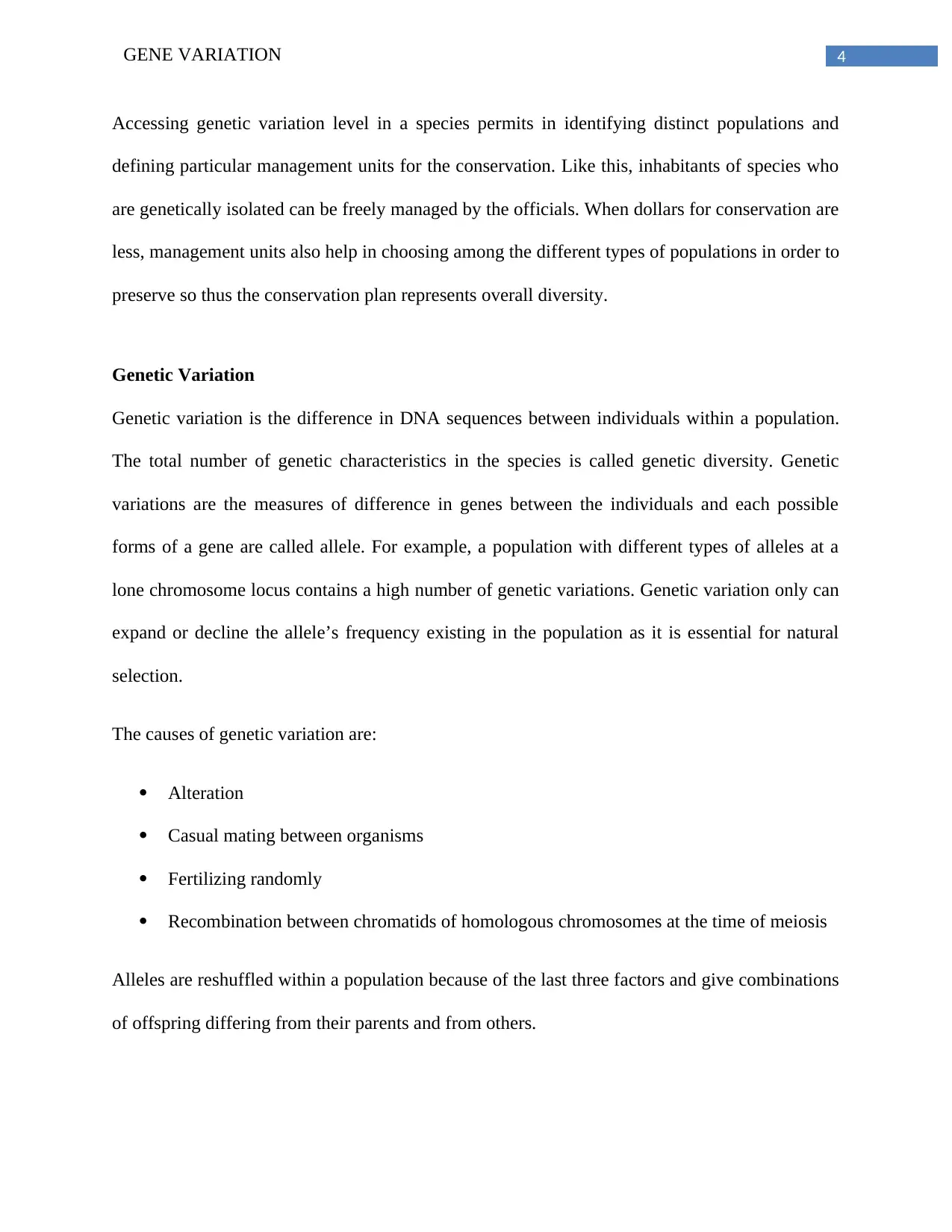
4GENE VARIATION
Accessing genetic variation level in a species permits in identifying distinct populations and
defining particular management units for the conservation. Like this, inhabitants of species who
are genetically isolated can be freely managed by the officials. When dollars for conservation are
less, management units also help in choosing among the different types of populations in order to
preserve so thus the conservation plan represents overall diversity.
Genetic Variation
Genetic variation is the difference in DNA sequences between individuals within a population.
The total number of genetic characteristics in the species is called genetic diversity. Genetic
variations are the measures of difference in genes between the individuals and each possible
forms of a gene are called allele. For example, a population with different types of alleles at a
lone chromosome locus contains a high number of genetic variations. Genetic variation only can
expand or decline the allele’s frequency existing in the population as it is essential for natural
selection.
The causes of genetic variation are:
Alteration
Casual mating between organisms
Fertilizing randomly
Recombination between chromatids of homologous chromosomes at the time of meiosis
Alleles are reshuffled within a population because of the last three factors and give combinations
of offspring differing from their parents and from others.
Accessing genetic variation level in a species permits in identifying distinct populations and
defining particular management units for the conservation. Like this, inhabitants of species who
are genetically isolated can be freely managed by the officials. When dollars for conservation are
less, management units also help in choosing among the different types of populations in order to
preserve so thus the conservation plan represents overall diversity.
Genetic Variation
Genetic variation is the difference in DNA sequences between individuals within a population.
The total number of genetic characteristics in the species is called genetic diversity. Genetic
variations are the measures of difference in genes between the individuals and each possible
forms of a gene are called allele. For example, a population with different types of alleles at a
lone chromosome locus contains a high number of genetic variations. Genetic variation only can
expand or decline the allele’s frequency existing in the population as it is essential for natural
selection.
The causes of genetic variation are:
Alteration
Casual mating between organisms
Fertilizing randomly
Recombination between chromatids of homologous chromosomes at the time of meiosis
Alleles are reshuffled within a population because of the last three factors and give combinations
of offspring differing from their parents and from others.
Paraphrase This Document
Need a fresh take? Get an instant paraphrase of this document with our AI Paraphraser
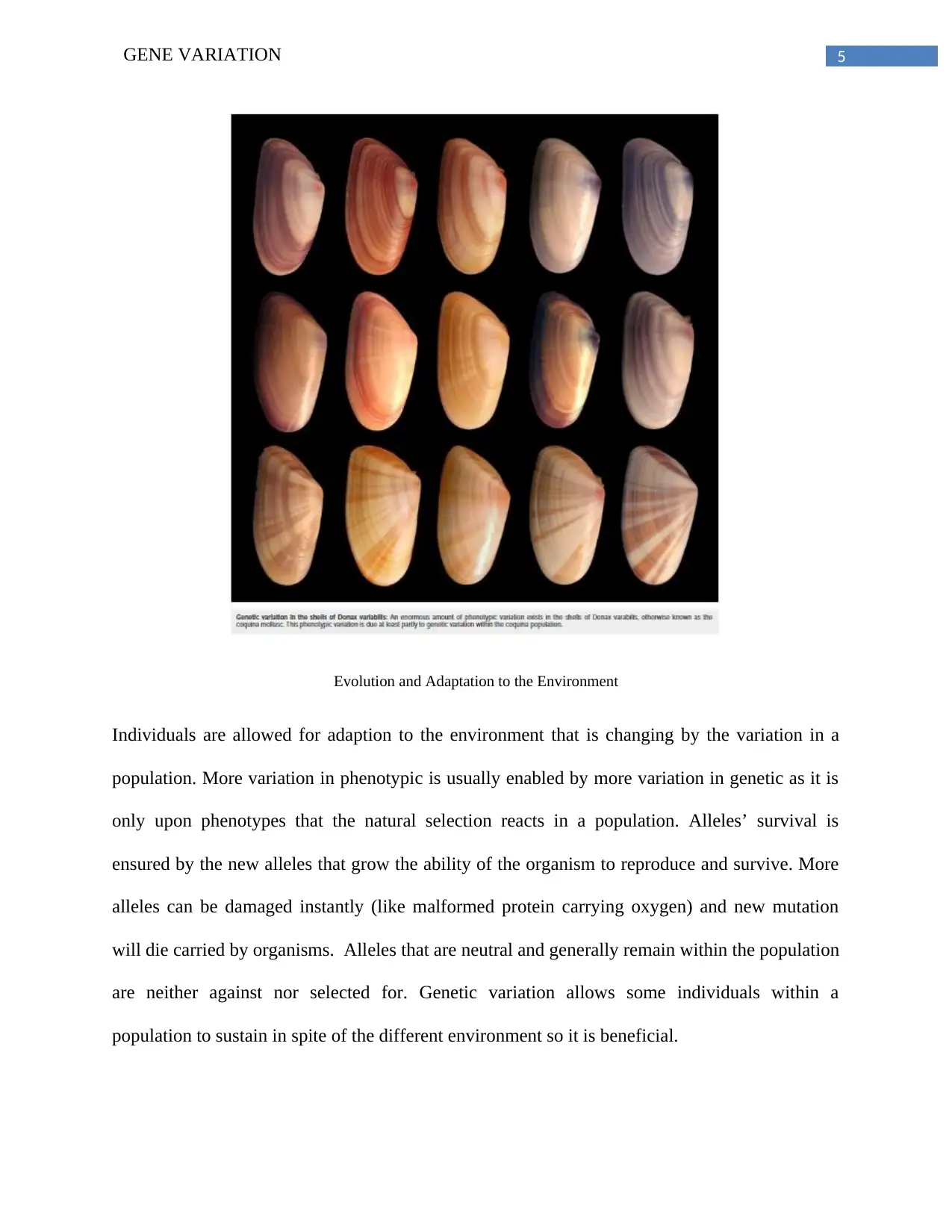
5GENE VARIATION
Evolution and Adaptation to the Environment
Individuals are allowed for adaption to the environment that is changing by the variation in a
population. More variation in phenotypic is usually enabled by more variation in genetic as it is
only upon phenotypes that the natural selection reacts in a population. Alleles’ survival is
ensured by the new alleles that grow the ability of the organism to reproduce and survive. More
alleles can be damaged instantly (like malformed protein carrying oxygen) and new mutation
will die carried by organisms. Alleles that are neutral and generally remain within the population
are neither against nor selected for. Genetic variation allows some individuals within a
population to sustain in spite of the different environment so it is beneficial.
Evolution and Adaptation to the Environment
Individuals are allowed for adaption to the environment that is changing by the variation in a
population. More variation in phenotypic is usually enabled by more variation in genetic as it is
only upon phenotypes that the natural selection reacts in a population. Alleles’ survival is
ensured by the new alleles that grow the ability of the organism to reproduce and survive. More
alleles can be damaged instantly (like malformed protein carrying oxygen) and new mutation
will die carried by organisms. Alleles that are neutral and generally remain within the population
are neither against nor selected for. Genetic variation allows some individuals within a
population to sustain in spite of the different environment so it is beneficial.
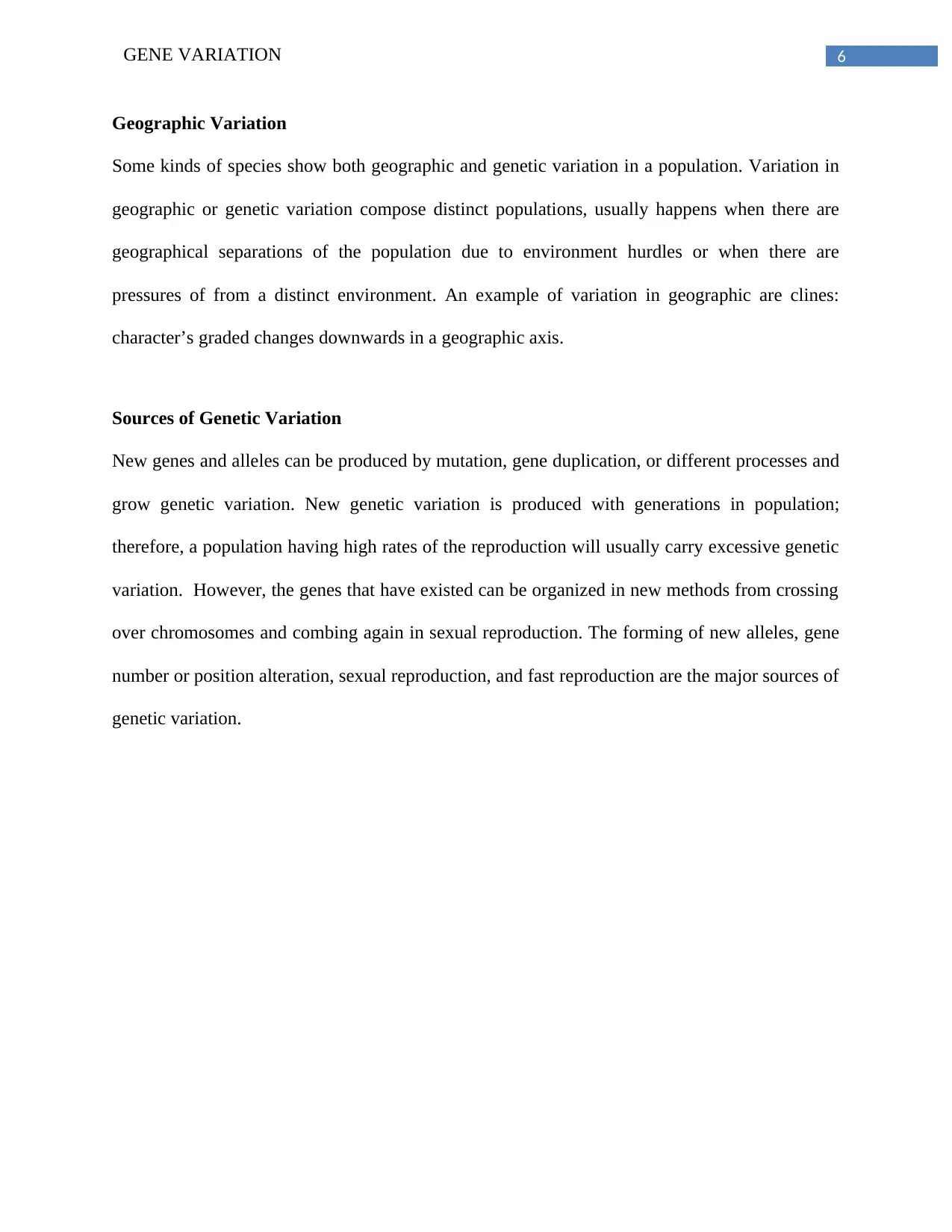
6GENE VARIATION
Geographic Variation
Some kinds of species show both geographic and genetic variation in a population. Variation in
geographic or genetic variation compose distinct populations, usually happens when there are
geographical separations of the population due to environment hurdles or when there are
pressures of from a distinct environment. An example of variation in geographic are clines:
character’s graded changes downwards in a geographic axis.
Sources of Genetic Variation
New genes and alleles can be produced by mutation, gene duplication, or different processes and
grow genetic variation. New genetic variation is produced with generations in population;
therefore, a population having high rates of the reproduction will usually carry excessive genetic
variation. However, the genes that have existed can be organized in new methods from crossing
over chromosomes and combing again in sexual reproduction. The forming of new alleles, gene
number or position alteration, sexual reproduction, and fast reproduction are the major sources of
genetic variation.
Geographic Variation
Some kinds of species show both geographic and genetic variation in a population. Variation in
geographic or genetic variation compose distinct populations, usually happens when there are
geographical separations of the population due to environment hurdles or when there are
pressures of from a distinct environment. An example of variation in geographic are clines:
character’s graded changes downwards in a geographic axis.
Sources of Genetic Variation
New genes and alleles can be produced by mutation, gene duplication, or different processes and
grow genetic variation. New genetic variation is produced with generations in population;
therefore, a population having high rates of the reproduction will usually carry excessive genetic
variation. However, the genes that have existed can be organized in new methods from crossing
over chromosomes and combing again in sexual reproduction. The forming of new alleles, gene
number or position alteration, sexual reproduction, and fast reproduction are the major sources of
genetic variation.
⊘ This is a preview!⊘
Do you want full access?
Subscribe today to unlock all pages.

Trusted by 1+ million students worldwide
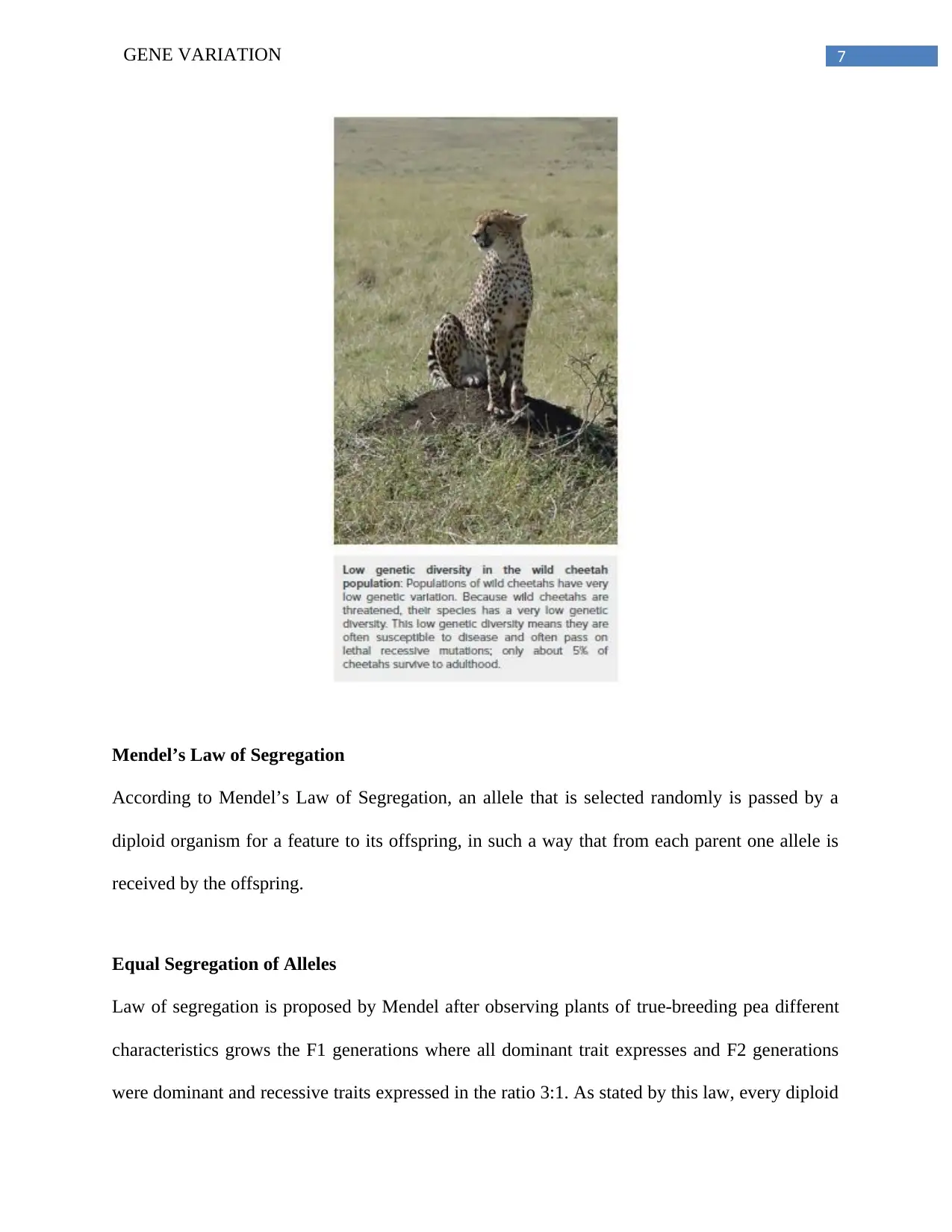
7GENE VARIATION
Mendel’s Law of Segregation
According to Mendel’s Law of Segregation, an allele that is selected randomly is passed by a
diploid organism for a feature to its offspring, in such a way that from each parent one allele is
received by the offspring.
Equal Segregation of Alleles
Law of segregation is proposed by Mendel after observing plants of true-breeding pea different
characteristics grows the F1 generations where all dominant trait expresses and F2 generations
were dominant and recessive traits expressed in the ratio 3:1. As stated by this law, every diploid
Mendel’s Law of Segregation
According to Mendel’s Law of Segregation, an allele that is selected randomly is passed by a
diploid organism for a feature to its offspring, in such a way that from each parent one allele is
received by the offspring.
Equal Segregation of Alleles
Law of segregation is proposed by Mendel after observing plants of true-breeding pea different
characteristics grows the F1 generations where all dominant trait expresses and F2 generations
were dominant and recessive traits expressed in the ratio 3:1. As stated by this law, every diploid
Paraphrase This Document
Need a fresh take? Get an instant paraphrase of this document with our AI Paraphraser

8GENE VARIATION
individual carries a pair of alleles for a specific trait. The phenotype of the offspring is
determined by the allele contacting dominant trait. Fundamentally, duplicates of alleles segregate
as each gamete gets only one allele.
In a monohybrid cross of the F2 generation, expected genotypes combinations result in
homozygous dominant, homozygous or heterozygous recessive. As two identical pathways give
individual carries a pair of alleles for a specific trait. The phenotype of the offspring is
determined by the allele contacting dominant trait. Fundamentally, duplicates of alleles segregate
as each gamete gets only one allele.
In a monohybrid cross of the F2 generation, expected genotypes combinations result in
homozygous dominant, homozygous or heterozygous recessive. As two identical pathways give
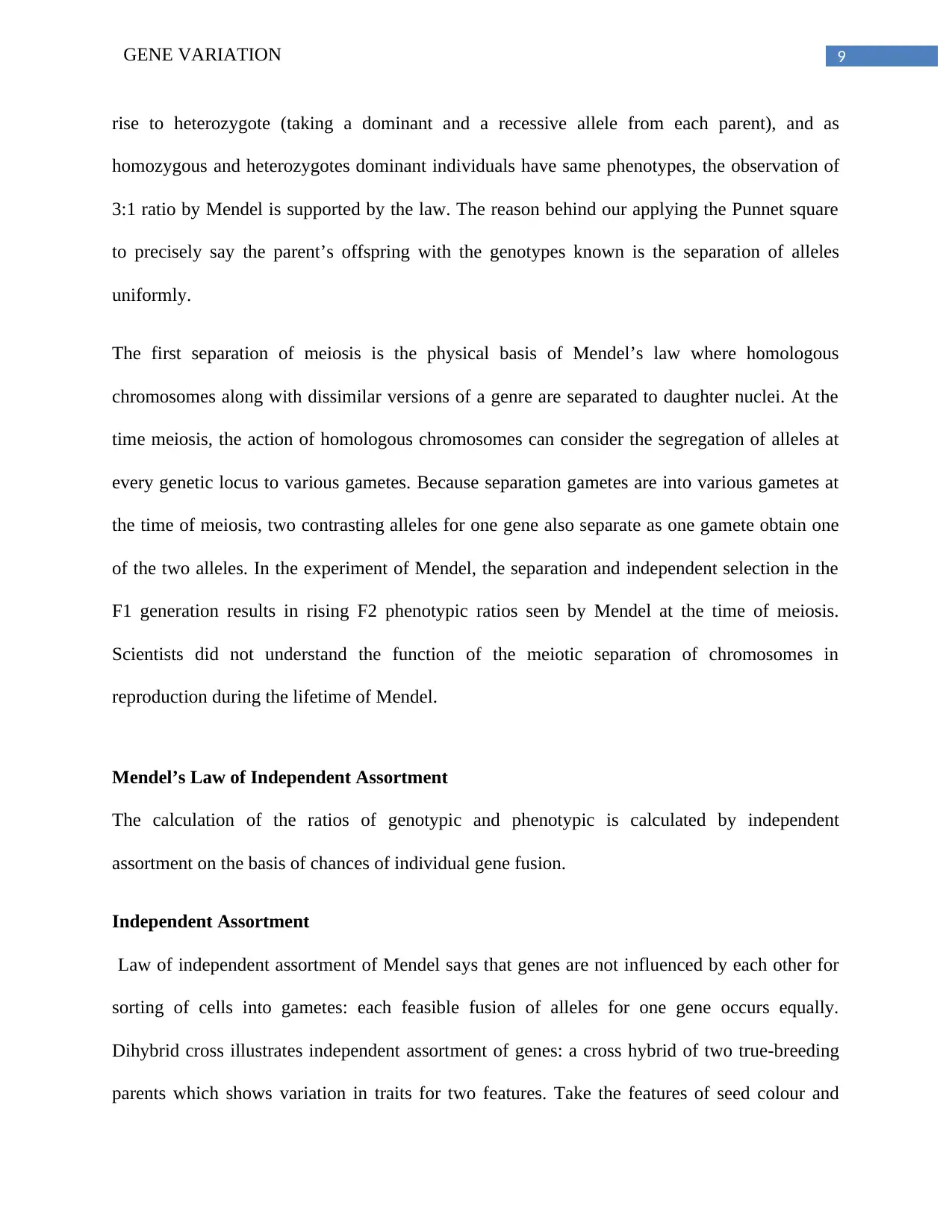
9GENE VARIATION
rise to heterozygote (taking a dominant and a recessive allele from each parent), and as
homozygous and heterozygotes dominant individuals have same phenotypes, the observation of
3:1 ratio by Mendel is supported by the law. The reason behind our applying the Punnet square
to precisely say the parent’s offspring with the genotypes known is the separation of alleles
uniformly.
The first separation of meiosis is the physical basis of Mendel’s law where homologous
chromosomes along with dissimilar versions of a genre are separated to daughter nuclei. At the
time meiosis, the action of homologous chromosomes can consider the segregation of alleles at
every genetic locus to various gametes. Because separation gametes are into various gametes at
the time of meiosis, two contrasting alleles for one gene also separate as one gamete obtain one
of the two alleles. In the experiment of Mendel, the separation and independent selection in the
F1 generation results in rising F2 phenotypic ratios seen by Mendel at the time of meiosis.
Scientists did not understand the function of the meiotic separation of chromosomes in
reproduction during the lifetime of Mendel.
Mendel’s Law of Independent Assortment
The calculation of the ratios of genotypic and phenotypic is calculated by independent
assortment on the basis of chances of individual gene fusion.
Independent Assortment
Law of independent assortment of Mendel says that genes are not influenced by each other for
sorting of cells into gametes: each feasible fusion of alleles for one gene occurs equally.
Dihybrid cross illustrates independent assortment of genes: a cross hybrid of two true-breeding
parents which shows variation in traits for two features. Take the features of seed colour and
rise to heterozygote (taking a dominant and a recessive allele from each parent), and as
homozygous and heterozygotes dominant individuals have same phenotypes, the observation of
3:1 ratio by Mendel is supported by the law. The reason behind our applying the Punnet square
to precisely say the parent’s offspring with the genotypes known is the separation of alleles
uniformly.
The first separation of meiosis is the physical basis of Mendel’s law where homologous
chromosomes along with dissimilar versions of a genre are separated to daughter nuclei. At the
time meiosis, the action of homologous chromosomes can consider the segregation of alleles at
every genetic locus to various gametes. Because separation gametes are into various gametes at
the time of meiosis, two contrasting alleles for one gene also separate as one gamete obtain one
of the two alleles. In the experiment of Mendel, the separation and independent selection in the
F1 generation results in rising F2 phenotypic ratios seen by Mendel at the time of meiosis.
Scientists did not understand the function of the meiotic separation of chromosomes in
reproduction during the lifetime of Mendel.
Mendel’s Law of Independent Assortment
The calculation of the ratios of genotypic and phenotypic is calculated by independent
assortment on the basis of chances of individual gene fusion.
Independent Assortment
Law of independent assortment of Mendel says that genes are not influenced by each other for
sorting of cells into gametes: each feasible fusion of alleles for one gene occurs equally.
Dihybrid cross illustrates independent assortment of genes: a cross hybrid of two true-breeding
parents which shows variation in traits for two features. Take the features of seed colour and
⊘ This is a preview!⊘
Do you want full access?
Subscribe today to unlock all pages.

Trusted by 1+ million students worldwide
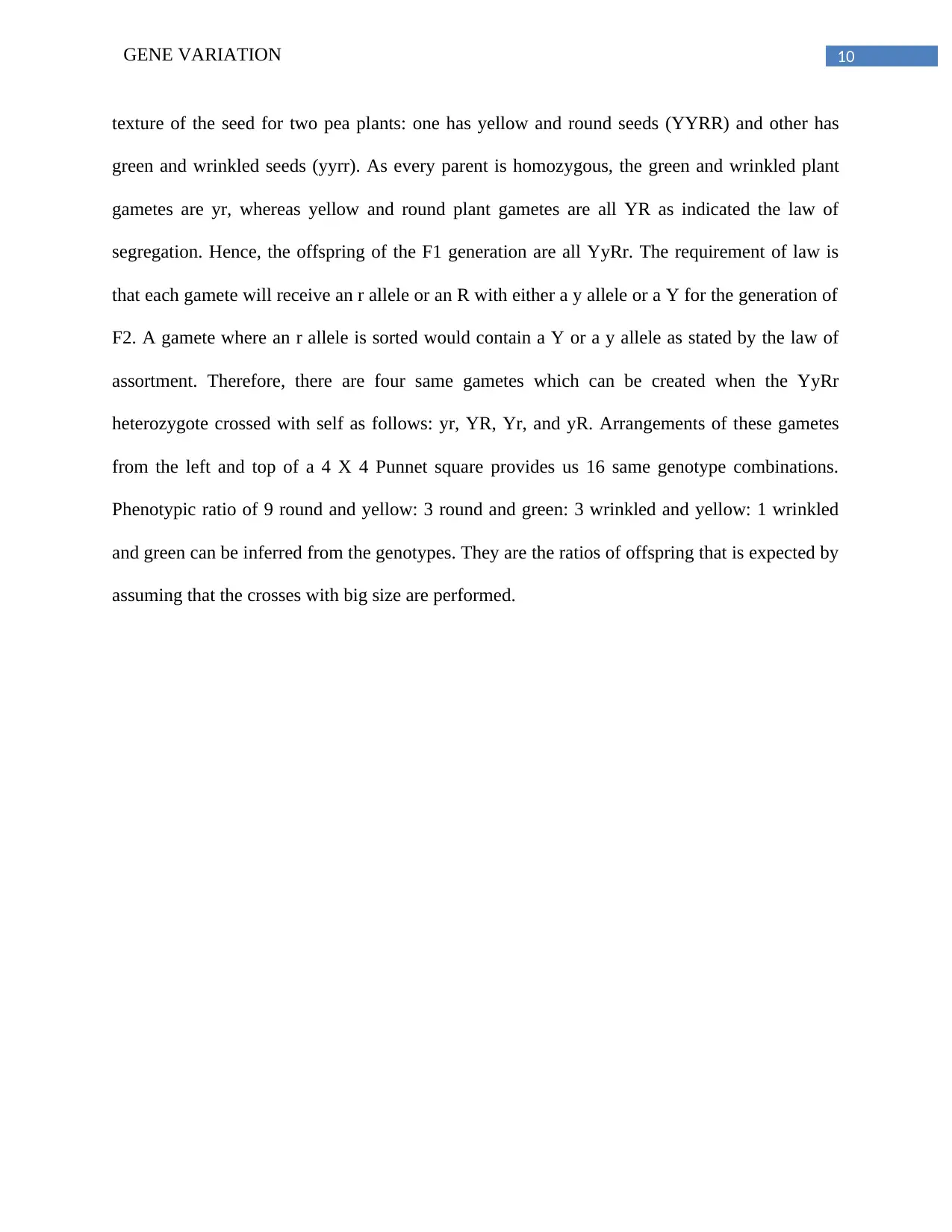
10GENE VARIATION
texture of the seed for two pea plants: one has yellow and round seeds (YYRR) and other has
green and wrinkled seeds (yyrr). As every parent is homozygous, the green and wrinkled plant
gametes are yr, whereas yellow and round plant gametes are all YR as indicated the law of
segregation. Hence, the offspring of the F1 generation are all YyRr. The requirement of law is
that each gamete will receive an r allele or an R with either a y allele or a Y for the generation of
F2. A gamete where an r allele is sorted would contain a Y or a y allele as stated by the law of
assortment. Therefore, there are four same gametes which can be created when the YyRr
heterozygote crossed with self as follows: yr, YR, Yr, and yR. Arrangements of these gametes
from the left and top of a 4 X 4 Punnet square provides us 16 same genotype combinations.
Phenotypic ratio of 9 round and yellow: 3 round and green: 3 wrinkled and yellow: 1 wrinkled
and green can be inferred from the genotypes. They are the ratios of offspring that is expected by
assuming that the crosses with big size are performed.
texture of the seed for two pea plants: one has yellow and round seeds (YYRR) and other has
green and wrinkled seeds (yyrr). As every parent is homozygous, the green and wrinkled plant
gametes are yr, whereas yellow and round plant gametes are all YR as indicated the law of
segregation. Hence, the offspring of the F1 generation are all YyRr. The requirement of law is
that each gamete will receive an r allele or an R with either a y allele or a Y for the generation of
F2. A gamete where an r allele is sorted would contain a Y or a y allele as stated by the law of
assortment. Therefore, there are four same gametes which can be created when the YyRr
heterozygote crossed with self as follows: yr, YR, Yr, and yR. Arrangements of these gametes
from the left and top of a 4 X 4 Punnet square provides us 16 same genotype combinations.
Phenotypic ratio of 9 round and yellow: 3 round and green: 3 wrinkled and yellow: 1 wrinkled
and green can be inferred from the genotypes. They are the ratios of offspring that is expected by
assuming that the crosses with big size are performed.
Paraphrase This Document
Need a fresh take? Get an instant paraphrase of this document with our AI Paraphraser
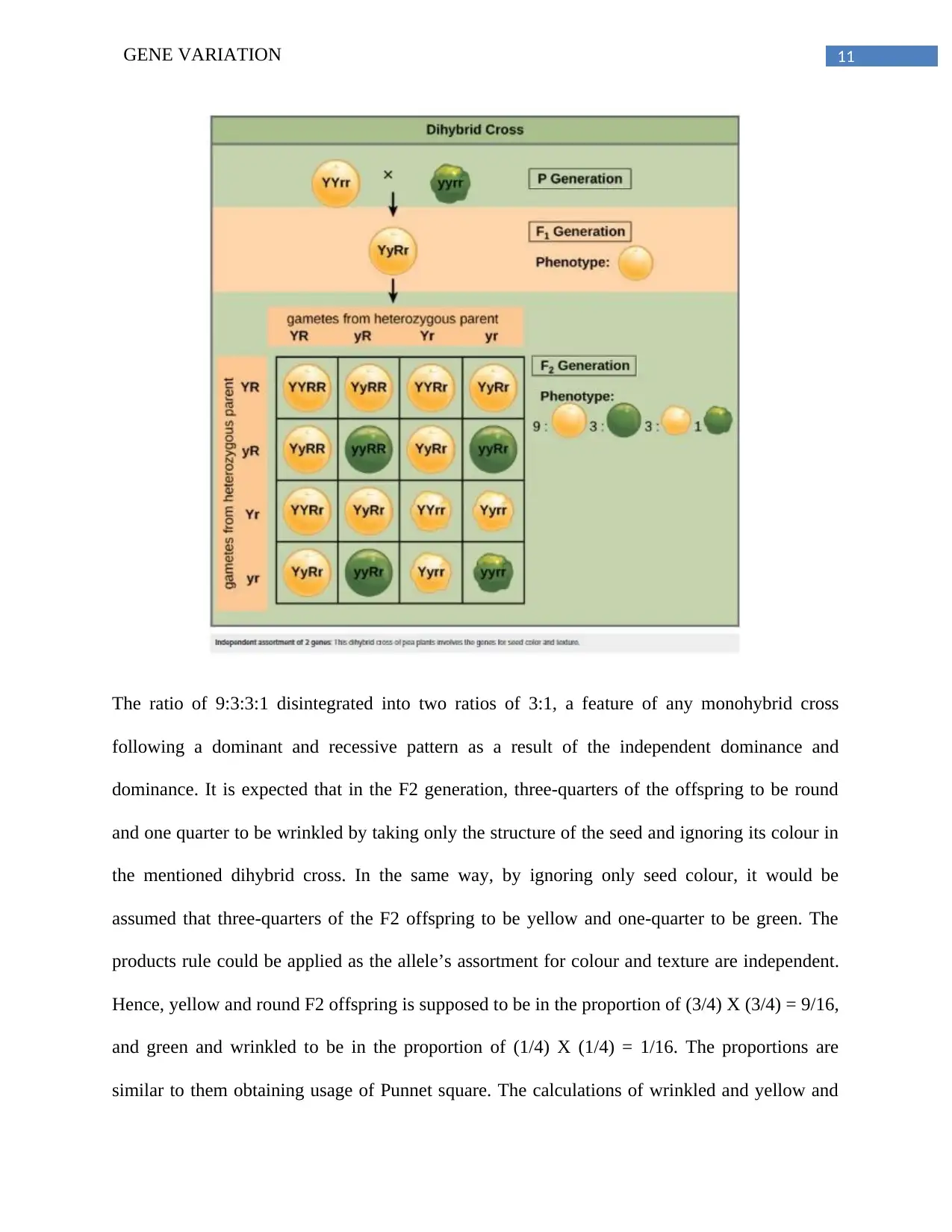
11GENE VARIATION
The ratio of 9:3:3:1 disintegrated into two ratios of 3:1, a feature of any monohybrid cross
following a dominant and recessive pattern as a result of the independent dominance and
dominance. It is expected that in the F2 generation, three-quarters of the offspring to be round
and one quarter to be wrinkled by taking only the structure of the seed and ignoring its colour in
the mentioned dihybrid cross. In the same way, by ignoring only seed colour, it would be
assumed that three-quarters of the F2 offspring to be yellow and one-quarter to be green. The
products rule could be applied as the allele’s assortment for colour and texture are independent.
Hence, yellow and round F2 offspring is supposed to be in the proportion of (3/4) X (3/4) = 9/16,
and green and wrinkled to be in the proportion of (1/4) X (1/4) = 1/16. The proportions are
similar to them obtaining usage of Punnet square. The calculations of wrinkled and yellow and
The ratio of 9:3:3:1 disintegrated into two ratios of 3:1, a feature of any monohybrid cross
following a dominant and recessive pattern as a result of the independent dominance and
dominance. It is expected that in the F2 generation, three-quarters of the offspring to be round
and one quarter to be wrinkled by taking only the structure of the seed and ignoring its colour in
the mentioned dihybrid cross. In the same way, by ignoring only seed colour, it would be
assumed that three-quarters of the F2 offspring to be yellow and one-quarter to be green. The
products rule could be applied as the allele’s assortment for colour and texture are independent.
Hence, yellow and round F2 offspring is supposed to be in the proportion of (3/4) X (3/4) = 9/16,
and green and wrinkled to be in the proportion of (1/4) X (1/4) = 1/16. The proportions are
similar to them obtaining usage of Punnet square. The calculations of wrinkled and yellow and
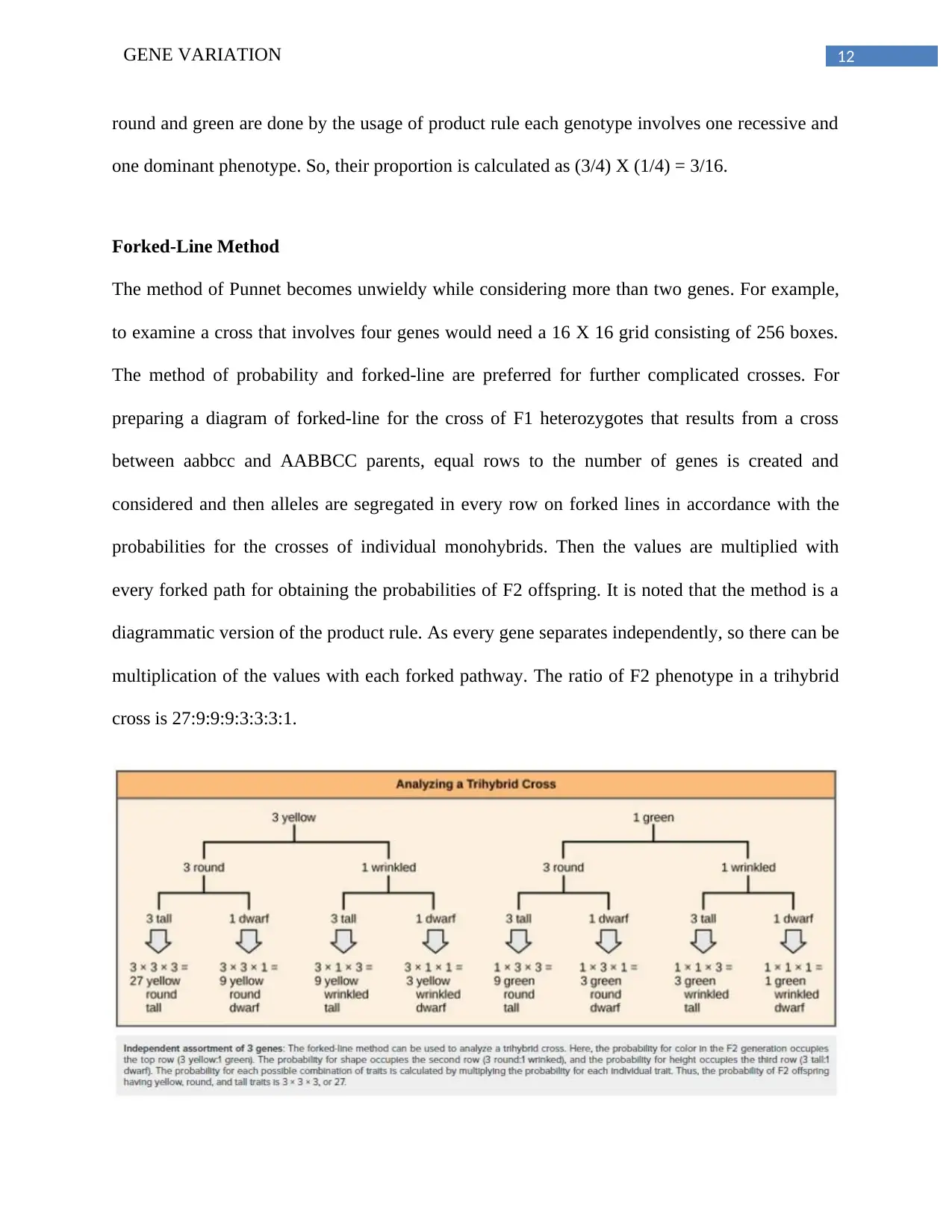
12GENE VARIATION
round and green are done by the usage of product rule each genotype involves one recessive and
one dominant phenotype. So, their proportion is calculated as (3/4) X (1/4) = 3/16.
Forked-Line Method
The method of Punnet becomes unwieldy while considering more than two genes. For example,
to examine a cross that involves four genes would need a 16 X 16 grid consisting of 256 boxes.
The method of probability and forked-line are preferred for further complicated crosses. For
preparing a diagram of forked-line for the cross of F1 heterozygotes that results from a cross
between aabbcc and AABBCC parents, equal rows to the number of genes is created and
considered and then alleles are segregated in every row on forked lines in accordance with the
probabilities for the crosses of individual monohybrids. Then the values are multiplied with
every forked path for obtaining the probabilities of F2 offspring. It is noted that the method is a
diagrammatic version of the product rule. As every gene separates independently, so there can be
multiplication of the values with each forked pathway. The ratio of F2 phenotype in a trihybrid
cross is 27:9:9:9:3:3:3:1.
round and green are done by the usage of product rule each genotype involves one recessive and
one dominant phenotype. So, their proportion is calculated as (3/4) X (1/4) = 3/16.
Forked-Line Method
The method of Punnet becomes unwieldy while considering more than two genes. For example,
to examine a cross that involves four genes would need a 16 X 16 grid consisting of 256 boxes.
The method of probability and forked-line are preferred for further complicated crosses. For
preparing a diagram of forked-line for the cross of F1 heterozygotes that results from a cross
between aabbcc and AABBCC parents, equal rows to the number of genes is created and
considered and then alleles are segregated in every row on forked lines in accordance with the
probabilities for the crosses of individual monohybrids. Then the values are multiplied with
every forked path for obtaining the probabilities of F2 offspring. It is noted that the method is a
diagrammatic version of the product rule. As every gene separates independently, so there can be
multiplication of the values with each forked pathway. The ratio of F2 phenotype in a trihybrid
cross is 27:9:9:9:3:3:3:1.
⊘ This is a preview!⊘
Do you want full access?
Subscribe today to unlock all pages.

Trusted by 1+ million students worldwide
1 out of 13
Related Documents
Your All-in-One AI-Powered Toolkit for Academic Success.
+13062052269
info@desklib.com
Available 24*7 on WhatsApp / Email
![[object Object]](/_next/static/media/star-bottom.7253800d.svg)
Unlock your academic potential
Copyright © 2020–2025 A2Z Services. All Rights Reserved. Developed and managed by ZUCOL.





